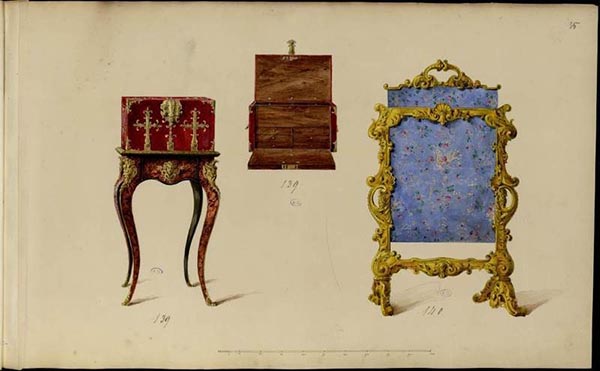Alphonse Giroux
Download PDFAlphonse Giroux, "the merchant of the princes", is an important Parisian manufacturer of luxury furniture and accessories, whose products were intended for an aristocratic and bourgeois clientele, installed as early as 1799 at No. 7, rue du Coq Saint -Honoré, then Boulevard des Capucines. Founded by François-Simon-Alphonse Giroux under the name "A. GIROUX in PARIS", it was taken over by the Giroux children and remained active under the name of "Alphonse Giroux et Cie" until 1867, when the direction is taken over by Ferdinand Duvinage .
The store founded by Giroux father often changes of description in the directory, and one guesses a very diversified activity. Specializing in paper and artistic supplies, he is also a restorer of paintings and proposes objects of fantasy and writing: writing desks, inkwells and also toys. Indeed, on June 6, 1818, he filed the patent for the kaleidoscope, which he also called the "transfigurator." This new toy is a huge success and Alphonse Giroux attracts a clientele in demand for luxury gifts. The store is successful under the Consulate, so that under the Restoration it is already important. Thus, Louis XVIII solicited Alphonse Giroux to produce the gifts of the children of France: a golden carriage now kept in the Carnavalet Museum. The horses in mother-of-pearl are harnessed with gold, and the coach is adorned with emeralds and glazed in rock crystal.
Moving towards cabinetmaking around 1830, the store continues to provide, among other things, beautiful objects that can be offered to children and ladies: toys, sewing kits, sewing tables, boxes and mirrors. The aesthetics of Alphonse Giroux's fabrics often takes inspiration from the styles of the 18th century, but it is far from repeating past models. These are creations, sometimes imbued with Troubadour style , but which will also be seduced by Japonism in the second half of the century. The furniture and accessories by Alphonse Giroux can thus vary in the inspirations, true artistic creations of their authors, but they are always of a perfect luxury.
This is the case of the cabinet exhibited at the World’s Fair of 1855 , which seduced the Empress Eugenie. This impressive carved linden furniture piece seems covered with climbing plants, which invade space and give it the aspect of being escaped from a tale.This cabinet is now kept in the Compiegne Palace.
Anxious to offer the best to its customers, the store remains at the forefront of progress. Thus, in decorative arts, he associated with Julien-Nicolas Rivart to create porcelain-inlaid piece of furniture, which remain unique examples of this process.
Interested in optics, Giroux father is not only the inventor of the kaleidoscope but also the exclusive depository of the daguerreotype, in collaboration with the Maison Susse. Daguerre and Niépce granted him in 1839 the exploitation of the process, so that the very first daguerreotypes, ancestors of the cameras, are stamped Alphonse Giroux, as well as the first photo papers provided by the store.
The Alphonse Giroux house was ceded to Duvinage, cousin of Alphonse Giroux son, in 1867, and was run by the widow Duvinage from 1874 to 1882. After a final takeover by Philippe and Arnut, the store closed definitively in 1885.
















